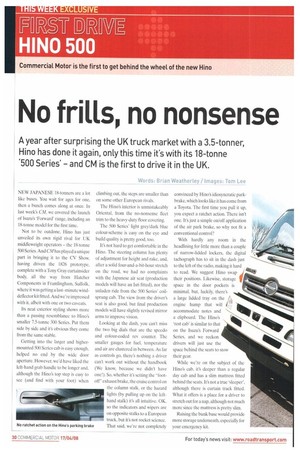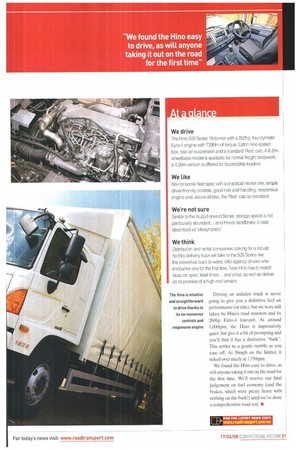No frills, no nonsense
Page 30

Page 31

If you've noticed an error in this article please click here to report it so we can fix it.
A year after surprising the UK truck market with a 3.5-tonner, Hino has done it again, only this time it's with its 18-tonne 1500 Series' and CM is the first to drive it in the UK.
NEW JAPANESE 18-tonners are a lot like buses. You wait for ages for one, then a bunch comes along at once. In last week's CM, we covered the launch of Isuzu's 'Forward' range, including an 18-tonne model for the first time.
Not to be outdone. Hino has just unveiled its own rigid rival for UK middleweight operators — the 18-tonne 500 Series. And CM has played a unique part in bringing it to the CV Show. having driven the 1826 prototype, complete with a Tony Gray curtainsider body, all the way from Hatcher Components in Framlingham. Suffolk, where it was getting a last—minute winddeflector kit fitted. And we're impressed with it. albeit with one or two caveats.
Its neat exterior styling shows more than a passing resemblance to Hino's smaller 7.5-tonne 300 Series. Put them side by side and it's obvious they come from the same stable, Getting into the larger and highermounted 500 Series cab is easy enough, helped no end by the wide door aperture. However, we'd have liked the left-hand grab handle to be longer and, although the Hino's top step is easy to see (and find with your foot) when climbing out, the steps are smaller than on some other European rivals.
The Hino's interior is unmistakeably Oriental, from the no-nonsense fleet trim to the heavy-duty floor covering.
The 500 Series' light grey/dark blue colour-scheme is easy on the eye and build quality is pretty good, too.
It's not hard to get comfortable in the Hino. The steering column has plenty of adjustment for height and rake, and, after a solid four-and-a-bit-hour stretch on the road, we had no complaints with the Japanese air seat (production models will have an Isri fitted), nor the unladen ride from the 500 Series' coilsprung cab. The view from the driver's seat is also good, but final production models will have slightly revised mirror arms to improve vision.
Looking at the dash, you can't miss the two big dials that are the speedo and colour-coded rev counter. The smaller gauges for fuel, temperature and air are clustered in between. As far as controls go, there's nothing a driver can't work out without the handbook (We know, because we didn't have one!). So, whether it's setting the "footoff' exhaust brake, the cruise control on the column stalk, or the hazard lights (by pulling up on the lefthand stalk) it's all intuitive. OK, so the indicators and wipers are on opposite stalks to a European truck, but it's not rocket science. That said, we're not completely convinced by Hino's idiosyncratic parkbrake, which looks like it has come from a Toyota. The first time you pull it up, you expect a ratchet action. There isn't one. It's just a simple on/off application of the air park brake, so why not fit a conventional control'?
With hardly any room in the headlining for little more than a couple of narrow-lidded lockers, the digital tachograph has to sit in the dash just to the left of the radio, making it hard to read. We suggest Hino swap their positions. Likewise, storage space in the door pockets is minimal, but, luckily, there's a large lidded tray on the / engine hump that will accommodate notes and a clipboard. The Hino's 'rest cab' is similar to that on the Isuzu's Forward Series, and we reckon drivers will just use the space behind the seats to stow their gear.
While we're on the subject of the Hino's cab, it's deeper than a regular day cab and has a slim mattress fitted behind the seats. It's not a true 'sleeper', although there is curtain track fitted. What it offers is a place for a driver to stretch out for a nap, although not much more since the mattress is pretty slim.
Raising the bunk base would provide more storage underneath, especially for your emergency kit. Driving an unladen truck is never going to give you a definitive feel on performance (or ride), but we were still taken by Hino's road manners and its 260hp Euro-4 four-pot. At around 1,000rpm, the Hino is impressively quiet, but give it a bit of prompting and you'll find it has a distinctive "bark". This settles to a gentle rumble as you ease off. At 56mph on the limiter, it ticked over nicely at 1,750rpm.
We found the Hino easy to drive, as will anyone taking it out on the road for the first time, We'll reserve our final judgement on fuel economy (and the brakes, which were pretty fierce with nothing on the back!) until we've done a comprehensive road test. •




























































































































































































